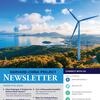Energy Systems
. 2023. “Off-design characteristics of energy conversion equipment in integrated energy systems.” Journal of Cleaner Production, 407, 25 June 2023, Pp. 136941. Publisher's VersionAbstract
2023
Apr
19
2023
Mar
08
2023
Feb
22
2023
Feb
08
. 2021. “Sustained methane emissions from China after 2012 despite declining coal production and rice-cultivated area.” Environmental Research Letters, 16, 10. Publisher's VersionAbstract
2023
Feb
10
. 2023. “Grid integration feasibility and investment planning of offshore wind power under carbon-neutral transition in China.” Nature Communications, 14, 2447. Publisher's VersionAbstract
2022
Nov
15
2022
Nov
30


 ) Tg CH4 yr−2) in China's methane emissions for 2010–2017. This trend was slowing down at a statistically significant rate of -0.1 ± 0.04 Tg CH4 yr−3. We find that this decrease in growth rate can in part be attributed to a decline in China's coal production. However, coal mine methane emissions have not declined as rapidly as production, implying that there may be substantial fugitive emissions from abandoned coal mines that have previously been overlooked. We also find that emissions over rice-growing and aquaculture-farming regions show a positive trend (0.13 ± 0.05 Tg CH4 yr−2 for 2010–2017) despite reports of shrinking rice paddy areas, implying potentially significant emissions from new aquaculture activities, which are thought to be primarily located on converted rice paddies.
) Tg CH4 yr−2) in China's methane emissions for 2010–2017. This trend was slowing down at a statistically significant rate of -0.1 ± 0.04 Tg CH4 yr−3. We find that this decrease in growth rate can in part be attributed to a decline in China's coal production. However, coal mine methane emissions have not declined as rapidly as production, implying that there may be substantial fugitive emissions from abandoned coal mines that have previously been overlooked. We also find that emissions over rice-growing and aquaculture-farming regions show a positive trend (0.13 ± 0.05 Tg CH4 yr−2 for 2010–2017) despite reports of shrinking rice paddy areas, implying potentially significant emissions from new aquaculture activities, which are thought to be primarily located on converted rice paddies.


